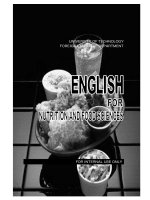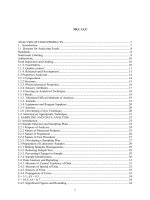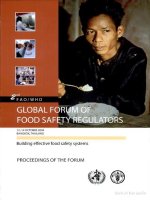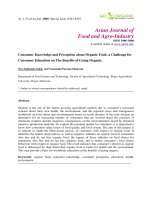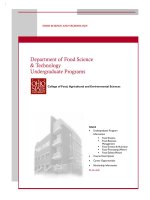vaclavik - essentials of food science 3e (springer, 2007)
Bạn đang xem bản rút gọn của tài liệu. Xem và tải ngay bản đầy đủ của tài liệu tại đây (8.39 MB, 565 trang )
ESSENTIALS
OF FOOD SCIENCE
ESSENTIALS
OF FOOD
SCIENCE
THIRD EDITION
VICKIE A. VACLAVIK
The University of Texas Southwestern Medical Center
At Dallas, Texas
Elizabeth W. Christian
Texas Woman’s University
Denton, Texas
Vickie A. Vaclavik Elizabeth W. Christian
The University of Texas Department of Nutrition and Food Sciences
Southwestern Medical Center at Dallas Texas Woman’s University
5323 Harry Hines Boulevard Denton Campus
Dallas, Texas 75390-8877 Denton, Texas 76204
USA USA
Series Editor
Dennis R. Heldman
1667 Portside PI.
San Marcos, CA 92078
USA
ISBN 978-0-387-69939-4 e-ISBN 978-0387-72897-1
Library of Congress Control Number: 2007934033
Printed on acid-free paper.
© 2008 Springer Science+Business Media, LLC.
All rights reserved. This work may not be translated or copied in whole or in part without the written permission of
the publisher (Springer Science+Business Media, LLC., 233 Spring Street, New York, NY 10013, USA), except
for brief excerpts in connection with reviews or scholarly analysis. Use in connection with any form of information
storage and retrieval, electronic adaptation, computer software, or by similar or dissimilar methodology now known
or hereafter developed is forbidden.
The use in this publication of trade names, trademarks, service marks and similar terms, even if they are not
identified as such, is not to be taken as an expression of opinion as to whether or not they are subject to proprietary
rights.
987654321
springer.com
Contents
Preface xv
World Wide Web (WWW) Sites xvii
PART I Introduction to Food Components 1
CHAPTER 1 Evaluation of Food Quality 3
Introduction 3
Aspects of Food Quality 4
Taste Sensitivity 5
Sensory Evaluation 6
Objective Evaluation 12
Comparison of Subjective and Objective Evaluation 17
Conclusion 18
Glossary 18
References 19
CHAPTER 2 Water 21
Introduction 21
Chemistry of Water 22
Specific Heat and Latent Heat of Water 23
Vapor Pressure and Boiling Point 24
Water as a Dispersing Medium 25
Free, Bound, and Entrapped Water 27
Water Activity (A
w
)28
Role of Water in Food Preservation and Shelf Life of Food 28
Water Hardness and Treatments 29
Beverage Consumption 29
Conclusion 29
v
vi Contents
Glossary 30
References 31
Bibliography 31
PART II Carbohydrates 33
CHAPTER 3 Carbohydrates in Food: An Introduction 35
Introduction 35
Monosaccharides 35
Disaccharides 39
Some Properties of Sugars 41
Oligosaccharides 43
Polysaccharides 44
Conclusion 46
Glossary 46
Bibliography 47
CHAPTER 4 Starches in Food 49
Introduction 49
Starch Sources 49
Starch Structure and Composition 50
Gelatinization Process 52
Factors Requiring Control in Gelatinization 54
Gelation or Setting of Gelatinized Starch Pastes During
Cooling 58
Retrogradation 59
Syneresis 60
Separating Agents and Lump Formation 60
Modified Starches 61
Waxy Starches 62
Starch Uses in Food Systems 63
Cooking With Starch 64
Nutritive Value of Starch 65
Conclusion 65
Glossary 66
References 67
Bibliography 67
CHAPTER 5 Pectins and Gums 69
Introduction 69
Pectic Substances 69
Gums 75
Conclusion 79
Glossary 79
References 80
Bibliography 80
Contents vii
CHAPTER 6 Grains: Cereal, Flour, Rice, and Pasta 81
Introduction 81
Structure of Cereal Grains 81
Composition Of Cereal Grains 83
Cereals 85
Common Cereal Grains and Their Uses 86
Other Grains 95
Noncereal “Flours” 97
Cooking Cereals 98
Breakfast Cereals 98
Pasta 98
Nutritive Value of Grains 100
Conclusion 102
Glossary 102
References 103
Bibliography 103
Glossary for Cereals, Flour, and Flour Mixtures 104
CHAPTER 7 Vegetables and Fruits 107
Introduction 107
Structure and Composition of Cell Tissue 107
Chemical Composition of Plant Material 109
Turgor Pressure 111
Pigments and Effects of Additional Substances 112
Flavor Compounds 118
Vegetable Classifications 120
Harvesting and Postharvest Changes 121
Ripening 122
Enzymatic Oxidative Browning 123
Cooking Effect 124
Fruits: Unique Preparation and Cooking Principles 126
Grading 128
Organically Grown Fruits and Vegetables 128
Biotechnology (See also Appendices) 129
Irradiation 130
Vegetarian Food Choices 130
Labeling of Vegetables and Fruits 131
Nutritive Value of Vegetables and Fruits 132
Safety of Vegetables and Fruits 136
Conclusion 137
Glossary 138
References 139
Bibliography 140
viii Contents
PART III Proteins 143
CHAPTER 8 Proteins in Food: An Introduction
1
145
Introduction 145
Amino Acids 146
Protein Structure and Conformation 148
Reactions and Properties of Proteins 151
Enzymes 155
Functional Roles of Proteins in Foods 156
Conjugated Proteins 157
Conclusion 157
Glossary 157
Bibliography 159
CHAPTER 9 Meat, Poultry, Fish, and Dried Beans 161
Introduction 161
Characteristics of Meat 162
Muscle Contraction in Live Animals 167
Postmortem Changes in the Muscle 169
Meat Pigments and Color Changes 171
Meat-Handling Process 173
Grading of Meat 175
Hormones and Antibiotics 176
Cuts of Meat 176
Cooking Meat 179
Alterations to Meat 182
Poultry 187
Fish 188
Dried Beans and Peas (Legumes) 190
Meat Alternatives 193
Nutritive Value of Meat, Poultry, and Fish 194
Safety 198
Conclusion 200
Glossary 201
References 202
Bibliography 203
Associations 204
CHAPTER 10 Eggs and Egg Products 205
Introduction 205
Physical Structure and Composition of Eggs 205
Egg Function 210
Inspections and Grading for Egg Quality 210
Egg Size 215
Processing/Preservation of Eggs 216
Storing Eggs 218
Contents ix
Denaturation and Coagulation 219
Effect of Added Ingredients on Coagulation 220
Cooking Changes 221
Egg White Foams and Meringues 224
Egg Products And Egg Substitutes 228
Nutritive Value of Eggs 229
Safety of Eggs 230
Conclusion 233
Glossary 233
References 234
Bibliography 235
CHAPTER 11 Milk and Milk Products
237
Introduction 237
Definition 238
Composition of Milk 238
Sanitation and Grading of Milk 242
Flavor of Milk 242
Milk Processing 243
Types of Milk 246
Other Milk Products 250
Whey 258
Cooking Applications 259
Milk Substitutes and Imitation Milk Products 260
Safety/Quality of Milk 261
Nutritive Value of Milk and Milk Products 262
Lactose Intolerance 265
Marketing Milk 265
Conclusion 266
Glossary 266
References 268
Bibliography 268
PART IV Fats 271
CHAPTER 12 Fat and Oil Products
273
Introduction 273
Structure and Composition of Fats 274
Structure of Fatty Acids 276
Nomenclature of Fatty Acids 278
Properties of Fats and Oils 280
Composition of Dietary Fats and Oils 283
Production and Processing Methods 285
Modification of Fats 286
Deterioration of Fats 288
Shortening and Shortening Power of Various Fats and Oils 292
x Contents
Emulsification (see also Chapter 13) 294
Frying 296
Low-Fat and No-Fat Foods 296
Fat Replacements 297
Nutritive Value of Fats and Oils 304
Conclusion 306
Glossary 306
References 308
Bibliography 309
CHAPTER 13 Food Emulsions and Foams 311
Introduction 311
Emulsions 311
Foams 321
Conclusion 325
Glossary 326
Bibliography 327
PART V Sugars 329
CHAPTER 14 Sugars, Sweeteners, and Confections 331
Introduction 331
Sources Of Sugar 331
Roles of sugar in food systems 331
Types of Sugars and Sugar Syrups 333
Properties of Sucrose 335
Sugar Substitutes 338
Confections 341
Nutritive Value of Sugars and Sweeteners 345
Conclusion 346
Glossary 346
References 347
Bibliography 347
PART VI Baked Products 349
CHAPTER 15 Baked Products: Batters and Dough 351
Introduction 351
Classes of Batters and Dough 352
Gluten 352
Function of Various Ingredients in Batters and Dough 355
The Leavening Process of Baked Products 361
Ingredients in Specific Baked Products 366
Mixing Methods for Various Batters and Doughs 370
Contents xi
Baking Batters and Doughs 373
Storage of Baked Products 375
Nutritive Value of Baked Products 375
Safety Issues in Batters and Doughs 375
Conclusion 376
Glossary 376
References 377
Bibliography 378
PART VII Aspects of Food Production 379
CHAPTER 16 Food Safety
381
Introduction 381
Foodborne Illness 382
Biological (Microbiological) Hazards
to The Food Supply 383
Chemical Hazards to The Food Supply 392
Physical Hazards to The Food Supply 393
Food Protection Systems 395
The Haccp System of Food Protection 397
Surveillance for Foodborne-Disease Outbreaks 409
Other Causes of Spoilage and Contamination 411
Labeling as A Means of Assuring Food Safety 411
Responsibility for Food Safety 413
Recalls 415
Bioterrorism Threat to Food Safety 415
Conclusion 421
Glossary 421
References 422
Bibliography 424
Associations and Organizations 424
CHAPTER 17 Food Preservation and Processing 425
Introduction 425
Heat Preservation 425
Refrigeration Preservation 433
Freezing 434
Dehydration 438
Concentration 439
Added Preservatives 440
Other Preservation Techniques 440
Radiation 440
Direct Contact Products 443
Nutritive Value of Preserved Foods 443
Safety of Preserved Foods 443
xii Contents
Conclusion 444
Glossary 444
References 445
Bibliography 445
CHAPTER 18 Food Additives 447
Introduction 447
Definition of Food Additives 448
Function of Food Additives 448
Legislation and Testing for Additives 449
Major Additives Used in Processing 451
Nutrient Supplements in Food 464
Conclusion 467
Glossary 468
References 468
Bibliography 469
CHAPTER 19 Packaging of Food Products 471
Introduction 471
Types of Packaging Containers 471
Packaging Functions 472
Packaging Materials 472
Controlling Packaging Atmosphere 480
Freezer Packaging Protection 491
Tamper-Evident Banding and Sleeve Labeling 492
Manufacturing Concerns in Packaging 493
Packaging of the Future 495
Radio Frequency Identification Tags 497
Packaging as a Communication and Marketing Tool 497
Conclusion 498
Glossary 498
References 499
Bibliography 500
PART VIII Government Regulation of the
Food Supply
501
CHAPTER 20 Government Regulation of the Food Supply
and Labeling
503
Introduction 503
The Food and Drug Administration 504
The United States Department of Agriculture 508
Food Security and An Emergency Plan 510
State and Local Health Departments 512
Additional Agencies Regulating The Food Supply 512
General Labeling 512
Contents xiii
Nutrition Labeling 514
Health Claims (more in Appendices) 518
Allergens 519
Labeling for Food Service 519
Conclusion 521
Glossary 521
References 522
Bibliography 523
APPENDICES
525
Introduction 525
Appendix A – Biotechnology and Genetically Modified
Organisms (GMOs) 526
Appendix B – Functional Foods 528
Appendix C – Nutraceuticals 532
Appendix D – Phytochemicals 533
Appendix E – Medical Foods 534
Appendix F – USDA Food Pyramid 535
Appendix G – Food Label Heath Claims 537
Appendix H – Research Chefs Association Certification as
a Culinary Scientist and More 539
Appendix I – Human Nutrigenomics 540
Glossary 541
References 541
INDEX 543
Preface
It is with great pleasure that we introduce Essentials of Food Science, third edition.
We hope that you find it more reader-friendly and more useful in explaining food
science concepts.
Essentials of Food Science continues to be designed to present principles of
food science with you, the nonmajor in mind: the Nutrition, Dietetics, Hospitality,
and Culinary Arts student enrolled in an introductory Food Science course.
What is new: There are updates in each chapter, some significant.
Additionally, considering the frequency with which terms are used on labels and
in the press, a new Appendices section views biotechnology, functional foods,
nutraceuticals, phytochemicals, and medical foods. To stay abreast of consumer
concerns, the subjects of the USDA Food Pyramid and food label health claims
are presented. As well, the Research Chefs Association certification is highlighted
and a brief observation of human nutrigenomics is included. ‘Culinary Alert!’
appears throughout chapters in the text. Each Culinary Alert! is designed to point
our culinary applications of the food science principle discussed.
The old expression “give credit where credit is due” is applicable to
authorship! So Thanks to the Lord for giving us grace to meet each challenge
in the process of writing. We are appreciative of student queries and of those
who provided materials used throughout Essentials of Food Science to offer better
explanations of the text. Thanks to the Vaclavik and Christian families, our
husbands and children.
More information is available in other texts relating to such topics as food
chemistry, food engineering, food packaging, food preparation, food safety, food
technology, nutrition and quantity foods, product evaluation, and in references
cited at the end of each chapter. Bold, italicized words appearing in the text of
each chapter are defined in a glossary at the completion of that chapter.
V. A. Vaclavik (vä -klä
-vi
`
k)
E. W. Christian
xv
World Wide Web
(WWW) Sites
FDA—
FDA Code of Federal Regulations— />USDA—
USDA database—c/foodcomp
The American Dietetic Association—
The Institute of Food Technologists—
The National Restaurant Association—
Food Pyramid—mypyramid.gov
All website addresses are subject to the site’s own discretion regarding current
usage.
xvii
PART I
Introduction to Food Components
CHAPTER 1
Evaluation of Food Quality
Introduction
Food quality is an important concept because the food people choose depends
largely on quality. Consumer preference is important to the food manufacturer,
who wants to gain as wide a share of the market for the product as possible.
Quality is difficult to define precisely, but it refers to the degree of excellence of
a food and includes all the characteristics of a food that are significant and that
make the food acceptable.
Whereas some attributes of a food, such as nutritional quality, can be
measured by chemical analysis, food acceptability is not easy to measure as it
is very subjective. In fact, consumers make subjective judgments using one or
more of the five senses every time they select or eat any food. For example,
potato chips, celery, and some cereals have a crunchy sound when they are eaten;
the taste and smell of foods can be highly appealing or unacceptable; and the
appearance and feel of a food also are important in determining its acceptability.
Food quality must be monitored on a regular day-to-day basis to ensure that
a uniform product is produced and that it meets the required quality control
standards. Companies also must monitor the quality of their products during
storage, while changing ingredients and developing new lines. Objective tests
using laboratory equipment are useful for routine quality control, but they cannot
measure consumer preference. The only sure way to determine what a population
thinks about any food is to ask them. This is done using sensory testing and
asking panelists to taste a food and give their opinion on it. Both sensory and
objective tests are important in evaluating food quality, and ideally they should
correlate with or complement each other.
Engineers at food manufacturers are constantly developing new products both
for “at-home” and eating-out markets. The intent is to better serve the customer’s
needs and wants.
3
4 Introduction to Food Components
Aspects of Food Quality
Food quality has both subjective and nonsubjective aspects. Appearance, texture,
and flavor are largely subjective attributes, whereas nutritional and bacterial
quality are not. The last two qualities can be measured objectively by chemical
analysis, by measuring bacterial counts, or using other specific tests (1, 2). They
will be mentioned only briefly in this chapter and the subjective qualities will be
discussed in detail.
Appearance
The appearance of a food includes its size, shape, color, structure, transparency or
turbidity, dullness or gloss, and degree of wholeness or damage. While selecting
a food and judging its quality, a consumer takes these factors into account, as
they are indeed an index of quality. For example, the color of a fruit indicates
how ripe it is, and color also is an indication of strength (as in tea or coffee),
degree of cooking, freshness, or spoilage (3, 4). Consumers expect foods to be of
a certain color, and if they are not, it is judged to be a quality defect. The same
is true for size, and one may choose large eggs over small ones, or large peaches
over small ones for example.
Structure is important in baked goods. For example, bread should have many
small holes uniformly spread throughout and not one large hole close to the
top. Turbidity is important in beverages; for example, orange juice is supposed
to be cloudy because it contains pulp, but white grape juice should be clear and
without any sediment, which would indicate a quality defect.
Texture
Texture refers to those qualities of a food that can be felt with the fingers, tongue,
palate, or teeth. Foods have different textures, such as crisp crackers or potato
chips, crunchy celery, hard candy, tender steaks, chewy chocolate chip cookies,
and creamy ice cream, to name but a few.
Texture also is an index of quality. The texture of a food can change as it is
stored, for various reasons. If fruits or vegetables lose water during storage, they
wilt or lose their turgor pressure, and a crisp apple becomes unacceptable and
leathery on the outside. Bread can become hard and stale on storage. Products
like ice cream can become gritty due to precipitation of lactose and growth of ice
crystals if the freezer temperature is allowed to fluctuate, allowing thawing and
refreezing.
Evaluation of texture involves measuring the response of a food when it is
subjected to forces such as cutting, shearing, chewing, compressing, or stretching.
Food texture depends on the rheological properties of the food (5). Rheology
is defined as the science of deformation and flow of matter or, in other words,
reaction of a food when a force is applied to it. Does it flow, bend, stretch, or
break? From a sensory perspective, the texture of a food is evaluated when it is
chewed. The teeth, tongue, and jaw exert a force on the food, and how easily it
Evaluation of Food Quality 5
breaks or flows in the mouth determines whether it is perceived as hard, brittle,
thick, runny, and so on. The term mouthfeel is a general term used to describe
the textural properties of a food as perceived in the mouth.
Subjective measurement of texture gives an indirect evaluation of the
rheological properties of a food. For example, a sensory panel might evaluate
viscosity as the consistency or mouthfeel of a food. However, viscosity can
be measured directly using a viscometer. Rheological properties therefore are
discussed in more detail in section “Objective Evaluation” of this chapter.
Flavor
Flavor is a combination of taste and smell and is largely subjective. If a person has
a cold, food usually seems to be tasteless. However, it is not the taste buds that are
affected but the sense of smell. Taste is detected by the taste buds at the tip, sides,
and back of the tongue, whereas aromas are detected by the olfactory epithelium
in the upper part of the nasal cavity. For any food to have an aroma, it must be
volatile, but volatile substances can be detected in very small amounts (vanillin
can be detected at a concentration of 2×10
−10
mg/liter of air). Aroma is a valuable
index of quality. A food often will smell bad before it looks bad, and old meat
can be easily detected by its smell. (However, foods that are contaminated with
pathogens may have no off-odor, so the absence of bad smell is not a guarantee
that the food, such as meat, is safe to eat.)
The taste of a food is a combination of five major tastes—salt, sweet, sour,
bitter, and umami. It is complex and hard to describe completely. Sweet and salt
tastes are detected primarily on the tip of the tongue, and so they are detected
quickly, whereas bitter tastes are detected mainly by taste buds at the back of the
tongue. It takes longer to perceive a bitter taste and it lingers in the mouth; thus,
bitter foods are often described as having an aftertaste. Sour tastes are mainly
detected by the taste buds along the side of the tongue.
Sugars, alcohols, aldehydes, and certain amino acids taste sweet to varying
degrees. Acids (such as vinegar, lemon juice, and the many organic acids present
in fruits) contribute the sour taste, saltiness is due to salts, including sodium
chloride, and bitter tastes are due to alkaloids such as caffeine, theobromine,
quinine, and other bitter compounds.
Umami is a taste that recently has been added to the other four. It is a savory
taste given by ingredients such as monosodium glutamate (MSG) and other flavor
enhancers. The umami taste is significant in Japanese foods and in snack foods
such as taco-flavored chips.
Taste Sensitivity
People vary in their sensitivity to different tastes. Sensitivity depends on the
length of time allowed to taste a substance. Sweet and salt tastes are detected
quickly (in less than a second), because they are detected by taste buds on the
tip of the tongue; in addition, they are usually very soluble compounds. Bitter
6 Introduction to Food Components
compounds, on the other hand, may take a full second to be detected because
they are detected at the back of the tongue. The taste may linger, producing a
bitter aftertaste.
Sensitivity to a particular taste also depends on the concentration of the
substance responsible for the taste. The threshold concentration is defined as the
concentration required for identification of a particular substance. The threshold
concentration may vary from person to person; some people are more sensitive
to a particular taste than others and therefore are able to detect it at a lower
concentration. Below the threshold concentration, a substance would not be
identified but may affect the perception of another taste. For example, subthreshold
salt levels increase perceived sweetness and decrease perceived acidity, whereas
subthreshold sugar concentrations make a food taste less salty than it actually
is. Although it is not clear why, flavor enhancers such as MSG also affect taste
sensitivity by intensifying a particular taste in a food.
Temperature of a food also affects its flavor. Warm foods generally taste
stronger and sweeter than cold foods. For example, melted ice cream tastes much
sweeter than frozen ice cream. There are two reasons for the effects of temperature
on flavor. The volatility of substances is increased at higher temperatures, and
so they smell stronger. Taste bud receptivity also is an important factor. Taste
buds are most receptive in the region between 68 and 86
F (20 and 30
C), and
so tastes will be more intense in this temperature range.
Psychological factors also affect taste sensitivity and perception. Judgments
about flavor are often influenced by preconceived ideas based on the appearance of
the food or on previous experience with a similar food. For example, strawberry-
flavored foods would be expected to be red. However, if colored green, because
of the association of green foods with flavors such as lime, it would be difficult
to identify the flavor as strawberry unless it was very strong. Color intensity also
affects flavor perception. A stronger color may cause perception of a stronger
flavor in a product, even if the stronger color is simply due to the addition of
more food coloring. Texture also can be misleading. A thicker product may be
perceived as tasting richer or stronger simply because it is thicker and not because
the thickening agent affects the flavor of the food. Other psychological factors that
may come into play when making judgments about the flavor of foods include
time of day (for example, certain tastes are preferred at breakfast time), general
sense of well-being, health, and previous reactions to a particular food or taste.
Sensory Evaluation
Sensory evaluation has been defined as a scientific method used to evoke, measure,
analyze, and interpret those responses to products as perceived through the senses
of sight, smell, touch, taste, and hearing (7). This definition has been accepted
and endorsed by sensory evaluation committees within both the Institute of Food
Technologists and the American Society for Testing and Materials. For more
detailed information on sensory evaluation, the reader is referred to the books by
Lawless and Heymann (8) and by Stone and Sidel (7).
Evaluation of Food Quality 7
Sensory testing utilizes one or more of the five senses to evaluate foods. Taste
panels, comprising groups of people, taste specific food samples under controlled
conditions and evaluate them in different ways depending on the particular
sensory test being conducted. This is the only type of testing that can measure
consumer preference and acceptability. When it comes to public opinion of a
product, there is no substitute for tasting by individual consumers.
In addition to a taste-panel evaluation, objective tests can be established that
correlate with sensory testing, which give an indication of consumer acceptability,
but this may not always be sufficient. In the development of new foods or when
changing an existing product, it is necessary to determine consumer acceptance
directly and objective testing is not sufficient, even though it may be a reliable,
objective indication of food quality.
Sensory methods may be used to determine:
1. whether foods differ in taste, odor, juiciness, tenderness, texture, and so on.
2. to what extent foods differ.
3. to ascertain consumer preferences and to determine whether a certain food is
acceptable to a specific consumer group.
Three types of sensory testing are commonly used, each with a different goal.
Discrimination or difference tests are designed to determine whether there is a
difference between products; descriptive tests determine the extent of difference
in specific sensory characteristics; and affective or acceptance/preference tests
determine how well the products are liked or which products are preferred. There
are important differences between these three types of tests. It is important to
select the appropriate type of test so that the results obtained are able to answer
the questions being asked about the products and are useful to the manufacturer
or product developer.
The appropriate tests must be used under suitable conditions in order for
results to be interpreted correctly. All testing must be carried out under controlled
conditions, with controlled lighting, sound (no noise), and temperature to
minimize distractions and other adverse psychological factors.
Sensory Testing Procedure
Sensory testing is carried out by members of a taste panel, preferably in individual
testing booths under controlled conditions. All distractions, bias, and adverse
psychological factors must be minimized so that the evaluation is truly an evalu-
ation of the sample being tested and not a reaction to adverse circumstances,
cultural prejudice, or the opinions of other testers. The noise level must be
controlled to avoid distractions, temperature and humidity should be within
an acceptable range, and lighting within the booth also must be monitored. In
addition, there should be no extraneous smells, which may distract people from
making judgments about the product under test.
Because color has a significant effect on subjective evaluation of a product,
color differences may need to be masked. This is achieved by using red lights
8 Introduction to Food Components
in the booths when necessary. It is important that people rate samples that
may have different color intensities on flavor and not simply on the fact that
they look different. For example, two brands of cheese puffs may look different
because one is a deeper shade of orange than the other, and so one could tell the
difference between them simply because of their color. However, there may not
be a difference in the taste. If the color difference is masked by conducting the
tests under red light, any differences detected could then be attributed to flavor
differences and not to color differences.
The samples usually are placed on a tray and passed to each panelist through
a hatch in front of the testing booth. The tray should contain a ballot that gives
specific instructions on how to evaluate the samples and a place for the panelist’s
response. A cracker and water are provided, in order to cleanse the palate before
tasting the samples. It is important that tasters have not eaten spicy or highly
flavored food before tasting food samples or their judgment may be impaired.
Preferably, panelists should not have eaten anything immediately prior to carrying
out a taste test.
Additionally, it is important that panelists cannot identify the products they
are tasting and that they do not know which sample is the same as their neighbor’s
sample, so that there is no room for bias in the results. This is accomplished
by assigning three-digit random numbers to each product. For example, if two
products are being tested (denoted product 1 and 2), each product is given at
least two different random numbers. Panelists sitting next to each other will not
be given samples with the same number, so that they cannot compare notes and
agree with each other and introduce bias into the results that way.
If two products are being tested, 50% of the panelists must test product 1
first, and the rest must test product 2 first, but the order of testing must be
randomized. This eliminates bias due to sample order and also due to any changes
in experimental conditions that may occur from the beginning to the end of the
test. The specific product order and random numbers seen by each panelist are
detailed on a master sheet to ensure that the test design is carried out correctly.
Sensory Tests
Discrimination or difference tests are used to determine if there is a perceivable
difference between products. Such tests would be used if a company was changing
the source of one of its ingredients or substituting one ingredient for another.
Difference tests also can be used to see if the quality of a product changes over
time or to compare the shelf life of a particular product packaged in different
packaging materials. For example, a difference test could be used to determine
if juices keep their flavor better when stored in glass bottles rather than in
plastic ones.
A small group of panelists may be used to conduct such tests and they may be
trained to recognize and describe the differences likely to occur in the products
being tested. For example, if trained panelists are testing different tea blends or
flavor bases, they have more experience than an average consumer in recognizing
Evaluation of Food Quality 9
TEST #_________ Panelist #_________
TRIANGLE DIFFERENCE TEST
PRODUCT _________
INSTRUCTIONS: Proceed when you are ready. (Quietly so as not to distract others.)
FOR EACH SAMPLE:
1) Take a bite of the cracker and a sip of water to rinse your mouth.
2) Two of the samples are the same and one is different. CIRCLE the ODD sample.
If you cannot tell, guess.
_________ _________ _________
3) Describe the reason why the ODD sample is DIFFERENT. (Please be specific.)
Figure1.1 Ballot for triangle sensory test (obtained from Dr. Clay King at the Sensory
Testing Laboratory at Texas Woman’s University, Denton, Texas).
particular flavors associated with such products, are more sensitive to differences,
and are able to describe them better. This partly is because they have been trained
to identify such flavors. However, they are likely to be experienced tea drinkers
(or tea connoisseurs) with a liking for different teas before they are trained for
taste-panel work. Such people may be employees of the company doing the testing
or members of a university research group. They would be expected to detect
small differences in the product flavor that would go unnoticed by most of the
general population. Thus, their evaluation would be important in trying to keep
a tea blend constant or in determining if there is a significant flavor difference
when the source of an ingredient is changed.
It also may be important to know if small differences in a product can be
detected by untrained consumers, who simply like the product and use it on a
regular basis. For this reason, difference tests often are conducted using larger
panels of untrained panelists.
Two of the most frequently used difference tests are the triangle test and the
duo–trio test. Typical ballots for these tests are given in Figures 1.1 and 1.2. These
ballots and the one shown in Figure 1.3 were developed at the sensory evaluation
laboratory at Texas Woman’s University, Denton, Texas by Dr. Clay King, in
conjunction with Coca-Cola Foods. The ballots have been used for consumer
testing of beverages and other foods at the university sensory facility.
In the triangle test, each panelist is given three samples, two of which are
alike, and is asked to indicate the odd sample. The panelists are asked to taste
the samples from left to right, cleansing their palate before each sample by taking
a bite of cracker and a sip of water. Then they circle the number on the ballot
sheet that corresponds to the sample they believe to be different. If they cannot
tell, they must guess. Statistics are applied to the results to see if there is a
significant difference among the products being tested. Because the panelists have
to guess which is the odd one if they cannot detect a difference, one third of them
10 Introduction to Food Components
TEST #_________ Panelist #_________
DUO–TRIO DIFFERENCE TEST
PRODUCT _________
INSTRUCTIONS: Proceed when you are ready. (Quietly so as not to distract others.)
FOR EACH SAMPLE:
1) Take a bite of the cracker and a sip of water to rinse your mouth.
2) CIRCLE the number of the sample which is THE SAME as the reference R. If
you cannot tell, guess.
R _________ _________
3) Why are R and the sample you chose the same?
Figure1.2 Ballot for duo–trio sensory test (obtained from Dr. Clay King at the Sensory
Testing Laboratory at Texas Woman’s University, Denton, Texas).
TEST #_________ Panelist #_________
LIKEABILITY RATING AND PAIRED PREFERENCE TEST
PRODUCT _________
INSTRUCTIONS: Proceed when you are ready. (Quietly so as not to distract others.)
Evaluate one sample at a time, working from top to bottom.
FOR EACH SAMPLE:
1) Take a bite of the cracker and a sip of water to rinse your mouth.
2) Taste the sample then CIRCLE the number which best expresses your opinion
of the sample.
SAMPLE CODE:_________
Likeability 1 2 3456789
Scale Dislike Extremely Like Extremely
SAMPLE CODE:_________
Likeability 1 2 3456789
Scale Dislike Extremely Like Extremely
Describe the DIFFERENCES between the two samples. (Please be specific.)
Taste the samples again, then circle the one you prefer.
_________ _________
Describe the reasons why you prefer the one you chose.
Figure 1.3 Ballot for likeability and paired preference sensory tests (obtained from
Dr. Clay King at the Sensory Testing Laboratory at Texas Woman’s University, Denton, Texas).
Evaluation of Food Quality 11
would pick the correct sample as being odd just by guessing. Therefore, more
than one third of the panelists must choose the correct answer for there to be a
significant difference among the products. For example, if there are 60 members
on a taste panel, 27 would need to choose the correct answer for the results
to be significant at a probability level of 0.05 and 30 correct answers would be
needed for significance at a probability level of 0.01. A probability level (or p
value) of 0.05 means that out of 100 trials, the same result would be obtained 95
times, indicating 95% confidence that the result is valid. A probability of 0.01 is
equivalent to 99% confidence in the significance of the results, because the same
result would be expected in 99 out of 100 trials. Statistical tables are available
to determine the number of correct answers required for significance at different
probability levels (9).
In the duo–trio test, each panelist is given a reference and two samples. He or
she is asked to taste the reference first and then each sample, working from left to
right, and circle on the ballot the sample that is the same as the reference. Again,
if a panelist cannot tell which sample is the same as the reference, he or she must
guess and statistics must be applied to the results to determine whether there is a
significant difference among the products. If everyone guessed, 50% of the panelists
would get the correct answer, and so for the results to be significant, more than 50%
must choose the correct answer. For a panel of 60 people, 40 must give the correct
answer for the results to be significant at the 0.01 probability level. Again, tables are
available to determine if results are statistically significant (9).
Affective, acceptance,orpreference tests are used to determine whether a
specific consumer group likes or prefers a particular product. This is necessary
for the development and marketing of new products, as no laboratory test can
tell whether the public will accept a new product or not. A large number of
panelists, representing the general public, must be used; thus, consumer testing
is expensive and time-consuming. A relevant segment of the population needs
to test the product. For example, if it is being aimed at over-50s, senior citizens
must make up the taste panel and not mothers with young children. The opposite
would apply if the product was aimed at young children. (Products aimed at
children would have to be acceptable to mothers as well, because they would be
the ones to buy it.) Ethnic products must be tested either by the group for which
they are aimed or by a wide cross section of the public if the aim is to introduce
the products to a broader market than is currently interested.
Panelists are not trained for this type of sensory testing. All that is required
from them is that they give their opinion of the sample(s). However, they are
normally screened to make sure that they are users or potential users of the
product to be tested. Typically, they are asked to fill out a screening sheet and
answer questions about how much they like the product (or similar products) and
how often they consume it. Anyone who does not like the product is asked not to
take the test. The screening sheet also may ask for demographic information, such
as gender and age range of the panelists. The specific questions for each screening
sheet are determined by whoever sets up the test, based on the consumer group
they aim to target with their product.


